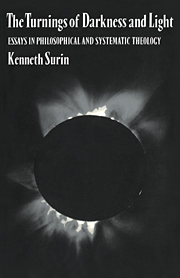Book contents
- Frontmatter
- Contents
- Dedication
- Preface
- Abbreviations
- 1 Creation, revelation and the analogy theory
- 2 The Trinity and philosophical reflection: a study of David Brown's The Divine Trinity
- 3 ‘Is it true what they say about “theological realism”?’
- 4 The impassibility of God and the problem of evil
- 5 Theodicy?
- 6 Tragedy and the soul's conquest of evil
- 7 Atonement and moral apocalypticism: William Styron's Sophie's Choice
- 8 Atonement and christology
- 9 Revelation, salvation, the uniqueness of Christ and other religions
- 10 ‘Many religions and the one true faith’: an examination of Lindbeck's chapter 3
- 11 Contemptus mundi and the disenchanted world: Bonhoeffer's ‘discipline of the secret’ and Adorno's ‘strategy of hibernation’
- 12 ‘The weight of weakness’: intratextuality and discipleship
- 13 ‘Theistic arguments’ and ‘rational theism’
- Notes
- Index of names
- Index of subjects
5 - Theodicy?
Published online by Cambridge University Press: 19 January 2010
- Frontmatter
- Contents
- Dedication
- Preface
- Abbreviations
- 1 Creation, revelation and the analogy theory
- 2 The Trinity and philosophical reflection: a study of David Brown's The Divine Trinity
- 3 ‘Is it true what they say about “theological realism”?’
- 4 The impassibility of God and the problem of evil
- 5 Theodicy?
- 6 Tragedy and the soul's conquest of evil
- 7 Atonement and moral apocalypticism: William Styron's Sophie's Choice
- 8 Atonement and christology
- 9 Revelation, salvation, the uniqueness of Christ and other religions
- 10 ‘Many religions and the one true faith’: an examination of Lindbeck's chapter 3
- 11 Contemptus mundi and the disenchanted world: Bonhoeffer's ‘discipline of the secret’ and Adorno's ‘strategy of hibernation’
- 12 ‘The weight of weakness’: intratextuality and discipleship
- 13 ‘Theistic arguments’ and ‘rational theism’
- Notes
- Index of names
- Index of subjects
Summary
Theodicy, in its classical form, requires the adherent of a theistic faith to reconcile the existence of an omnipotent, omniscient and morally perfect God with the existence of evil. The so-called problem of evil has a venerable ancestry, extending beyond the Christian era, and was apparently first formulated by Epicurus (341-270 BC) in the form of a dilemma which perhaps receives its most succinct formulation in the words of David Hume:
Is he willing to prevent evil, but not able? then he is impotent. Is he able, but not willing? then he is malevolent. Is he both able and willing? whence then is evil?
A long strand in the history of theology, stemming from St Augustine via St Thomas Aquinas and the Reformers to Schleiermacher and modern times, has addressed itself to the task of reconciling God's omnipotence, omniscience and benevolence with the existence of evil. And yet, despite the efforts of these and other theologians, the thought persists in many quarters that theodicy is perhaps one of the least satisfactory areas of the theological enterprise. Confronted with the seemingly innumerable ‘solutions’ to the problem of evil that have been advanced over the centuries, one cannot help thinking that Kant's complaint about metaphysics is probably just as applicable to theodicy:
[it] has rather to be regarded as a battle-ground quite peculiarly suited for those who desire to exercise themselves in mock combats, and in which no participant has ever yet succeeded in gaining so much as an inch of territory, not at least in such manner as to secure him its permanent possession.
- Type
- Chapter
- Information
- The Turnings of Darkness and LightEssays in Philosophical and Systematic Theology, pp. 73 - 90Publisher: Cambridge University PressPrint publication year: 1989

